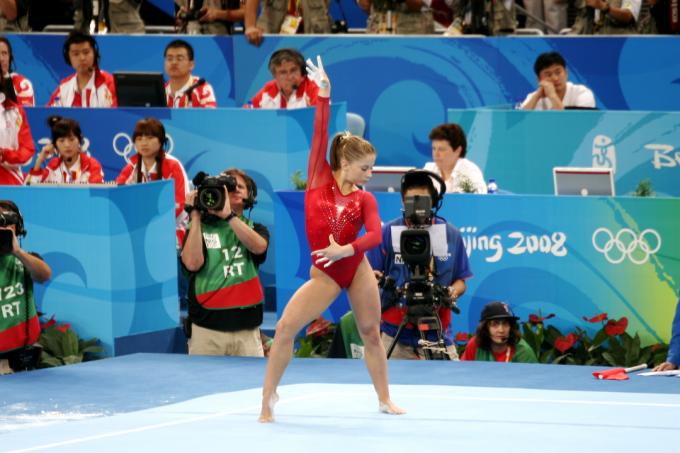Initially called Olympic gymnastics, the current artistic gymnastics started to have this name when rhythmic gymnastics and trampoline gymnastics were included. Previously aimed only at male competitors, today, the modality has excellent competitors, both in male and female competitions.

see more
Spaniard runs 100 meters high jump and breaks world record;…
Discover the only two Brazilian teams Messi would consider…
In Brazil, some gymnasts who shone in world competitions are the brothers Diego and Daniele Hypólito, Daiane dos Santos, Jade Barbosa and Laís Souza.
History of Artistic Gymnastics
Despite only being officially transformed into a sport in the 19th century, gymnastics has existed since ancient Greece. According to historical records, already at that time the Greeks were already practicing acrobatics on some devices, but with the intention of achieving body perfection, which was worshiped at the time.
In addition, it was also used to prepare athletes for other sports and also during military training.
But it was only at the beginning of the 19th century that it came to be considered as a sport. The person responsible for this was Friedrich Ludwig Christoph Jahn (1778-1852), a German pedagogue who founded several gymnastics clubs to attract young people interested in practicing it.

It was also at this time that several devices were created, including some that are still used today.
However, the modality was considered dangerous, and Friedrich Jahn, for some the “father of gymnastics”, ended up in jail and the modality banned. To get around the impediment, some Germans who were passionate about the sport took it to other European countries.
It was only in 1881, with the creation of the European Gymnastics Federation, that sports practice began to consolidate. From then on, within a few years, in 1896, she was present at the Olympic Games in Athens, but only in the men's modality. Women only started competing in 1928, in the edition of the games in Holland. The entrance to the Pan American Games took place in 1951.
In Brazil, it began to gain space at the end of the 19th century, brought to the country by European immigrants, it quickly gained notoriety, mainly in the south of the country, where the greatest concentration of people from Europe.
The first societies and federations were created between 1858 and 1868, but it was only in the 20th century that the sport began to spread throughout the rest of the country. At that time, athletes from São Paulo and Rio de Janeiro began to practice it in clubs.
In 1950, the first national championship took place, with competitors from São Paulo, Rio Grande do Sul and Rio de Janeiro competing. And in 1978 the Brazilian Gymnastics Confederation (CBG) was created, which later joined the International Gymnastics Federation (FIG), responsible for organizing world competitions.
The country's first participation in the Olympics took place in the Moscow games in 1980. Since then, it has experienced exponential growth, with athletes standing out in competitions around the world.
Solo artistic gymnastics

This modality can be practiced by both men and women. In these events, athletes use jumps, turns, acrobatics and steps to perform perfectly.
Some of the main movements are:
- Double Twist Pike
- extended
- Plane
- carp
- Demidov
- Opening
- grips
- Flic-Flac
To execute them, it is necessary to respect the limits of the court, which is shaped like a square, with 12 meters on each side. Male competitors have 70 seconds to execute their movements, without music accompaniment, while for women this time is 90 seconds and they have a musical background.
There are judges to evaluate the performances, and the greater the degree of difficulty, the higher the grade assigned to the gymnast. But if errors are detected, he will lose some points.
jump

Jumping competitions are held on a track 25 m long, with a springboard 1.20 m long and 95 cm wide. The height varies according to the gender of the competitors, being 1.25 for women and 1.35 for men.
After a run, they should place their hands on the trampoline in order to jump and perform body rotation movements while in the air.
main appliances
In addition to the modalities that only involve movements on the ground and jumps, gymnastics has a series of devices in its competitions, these are different for male and female competitors, and have very specific rules.
While for male candidates the goal is to demonstrate strength and balance, for women, the The aim is to demonstrate the beauty of gymnastics movements, even enabling a better choreography defined.
See below what are the main apparatus of artistic gymnastics:
Masculine
- Rings
- fixed bars
- Parallel bars
- pommel horse
Feminine
- uneven bars
- balance bars
Both in jumping and in these devices, it is common for competitors to use magnesium powder and wrap ribbons on the feet to improve grip, ensuring greater firmness and stability, in addition to preventing injuries to the skin.
Rules
As already mentioned above, the objective of the competitors is to reach the perfection of the movements. For this, many young people have an intense and rigid training routine, with endless repetitions of movements.
There is a predetermined sequence, both for devices and for the floor, and the gymnasts have a certain amount of time to perform them. For each device, there are specific rules, which may vary, including according to gender.
